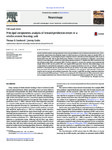Principal components analysis of reward prediction errors in a reinforcement learning task
| dc.contributor.author | Sambrook, TD | |
| dc.contributor.author | Goslin, Jeremy | |
| dc.date.accessioned | 2017-09-22T14:33:09Z | |
| dc.date.available | 2017-09-22T14:33:09Z | |
| dc.date.issued | 2016-01 | |
| dc.identifier.issn | 1053-8119 | |
| dc.identifier.issn | 1095-9572 | |
| dc.identifier.uri | http://hdl.handle.net/10026.1/9973 | |
| dc.description.abstract |
Models of reinforcement learning represent reward and punishment in terms of reward prediction errors (RPEs), quantitative signed terms describing the degree to which outcomes are better than expected (positive RPEs) or worse (negative RPEs). An electrophysiological component known as feedback related negativity (FRN) occurs at frontocentral sites 240-340ms after feedback on whether a reward or punishment is obtained, and has been claimed to neurally encode an RPE. An outstanding question however, is whether the FRN is sensitive to the size of both positive RPEs and negative RPEs. Previous attempts to answer this question have examined the simple effects of RPE size for positive RPEs and negative RPEs separately. However, this methodology can be compromised by overlap from components coding for unsigned prediction error size, or "salience", which are sensitive to the absolute size of a prediction error but not its valence. In our study, positive and negative RPEs were parametrically modulated using both reward likelihood and magnitude, with principal components analysis used to separate out overlying components. This revealed a single RPE encoding component responsive to the size of positive RPEs, peaking at ~330ms, and occupying the delta frequency band. Other components responsive to unsigned prediction error size were shown, but no component sensitive to negative RPE size was found. | |
| dc.format.extent | 276-286 | |
| dc.format.medium | Print-Electronic | |
| dc.language | en | |
| dc.language.iso | eng | |
| dc.publisher | Elsevier BV | |
| dc.subject | Adult | |
| dc.subject | Cerebral Cortex | |
| dc.subject | Delta Rhythm | |
| dc.subject | Electroencephalography | |
| dc.subject | Evoked Potentials | |
| dc.subject | Feedback, Psychological | |
| dc.subject | Female | |
| dc.subject | Humans | |
| dc.subject | Male | |
| dc.subject | Principal Component Analysis | |
| dc.subject | Reinforcement, Psychology | |
| dc.subject | Reward | |
| dc.subject | Theta Rhythm | |
| dc.subject | Young Adult | |
| dc.title | Principal components analysis of reward prediction errors in a reinforcement learning task | |
| dc.type | journal-article | |
| dc.type | Journal Article | |
| plymouth.author-url | https://www.webofscience.com/api/gateway?GWVersion=2&SrcApp=PARTNER_APP&SrcAuth=LinksAMR&KeyUT=WOS:000366646700028&DestLinkType=FullRecord&DestApp=ALL_WOS&UsrCustomerID=11bb513d99f797142bcfeffcc58ea008 | |
| plymouth.issue | Pt A | |
| plymouth.volume | 124 | |
| plymouth.publication-status | Published | |
| plymouth.journal | NeuroImage | |
| dc.identifier.doi | 10.1016/j.neuroimage.2015.07.032 | |
| plymouth.organisational-group | /Plymouth | |
| plymouth.organisational-group | /Plymouth/Faculty of Health | |
| plymouth.organisational-group | /Plymouth/Faculty of Health/School of Psychology | |
| plymouth.organisational-group | /Plymouth/REF 2021 Researchers by UoA | |
| plymouth.organisational-group | /Plymouth/REF 2021 Researchers by UoA/UoA04 Psychology, Psychiatry and Neuroscience | |
| plymouth.organisational-group | /Plymouth/REF 2021 Researchers by UoA/UoA04 Psychology, Psychiatry and Neuroscience/UoA04 REF peer reviewers | |
| plymouth.organisational-group | /Plymouth/Research Groups | |
| plymouth.organisational-group | /Plymouth/Research Groups/Centre for Brain, Cognition and Behaviour (CBCB) | |
| plymouth.organisational-group | /Plymouth/Research Groups/Centre for Brain, Cognition and Behaviour (CBCB)/Brain | |
| plymouth.organisational-group | /Plymouth/Users by role | |
| plymouth.organisational-group | /Plymouth/Users by role/Academics | |
| dc.publisher.place | United States | |
| dcterms.dateAccepted | 2015-07-12 | |
| dc.rights.embargodate | 2017-01-01 | |
| dc.identifier.eissn | 1095-9572 | |
| dc.rights.embargoperiod | 12 months | |
| rioxxterms.versionofrecord | 10.1016/j.neuroimage.2015.07.032 | |
| rioxxterms.licenseref.uri | http://www.rioxx.net/licenses/under-embargo-all-rights-reserved | |
| rioxxterms.licenseref.startdate | 2016-01-01 | |
| rioxxterms.type | Journal Article/Review |


